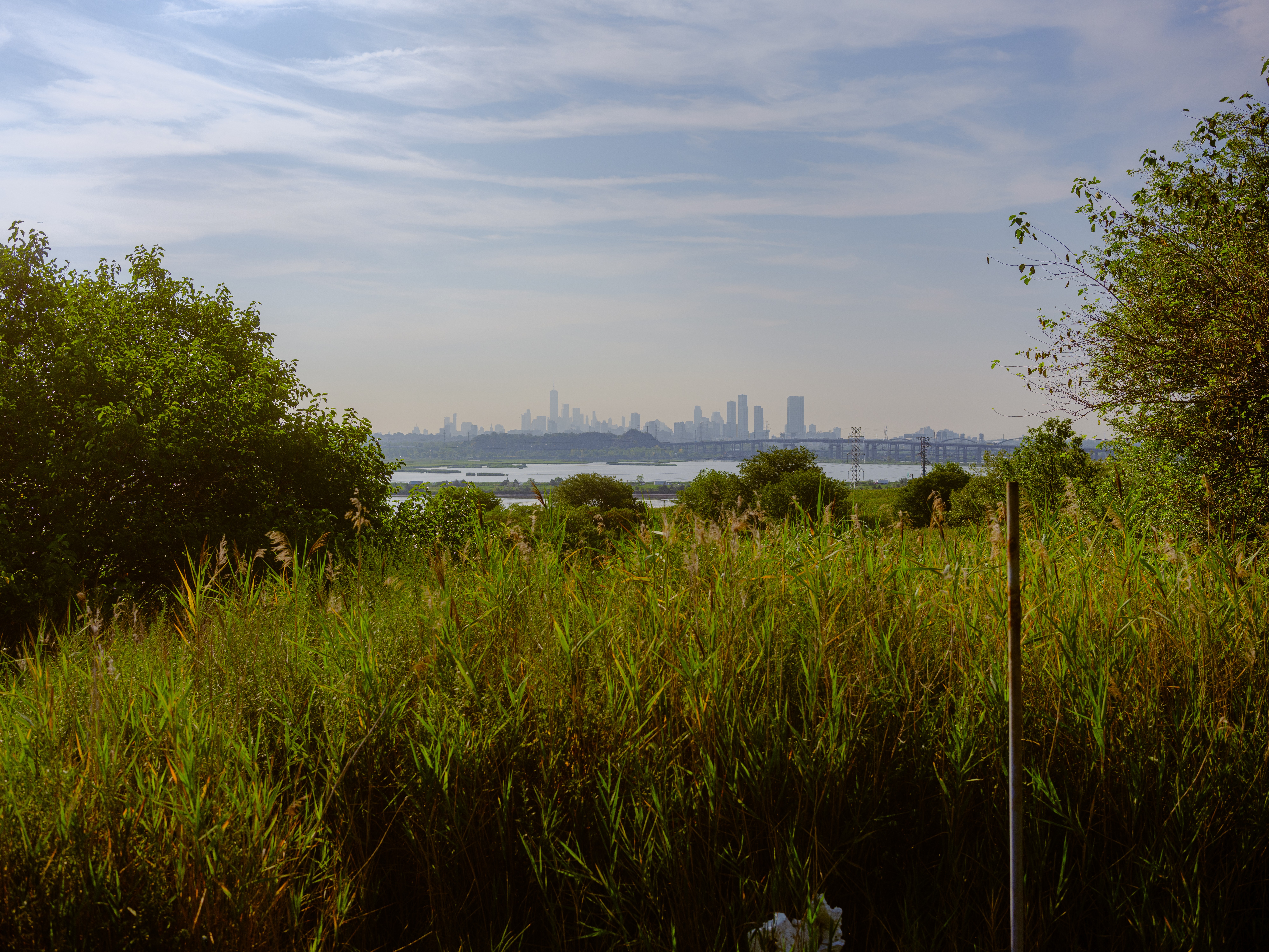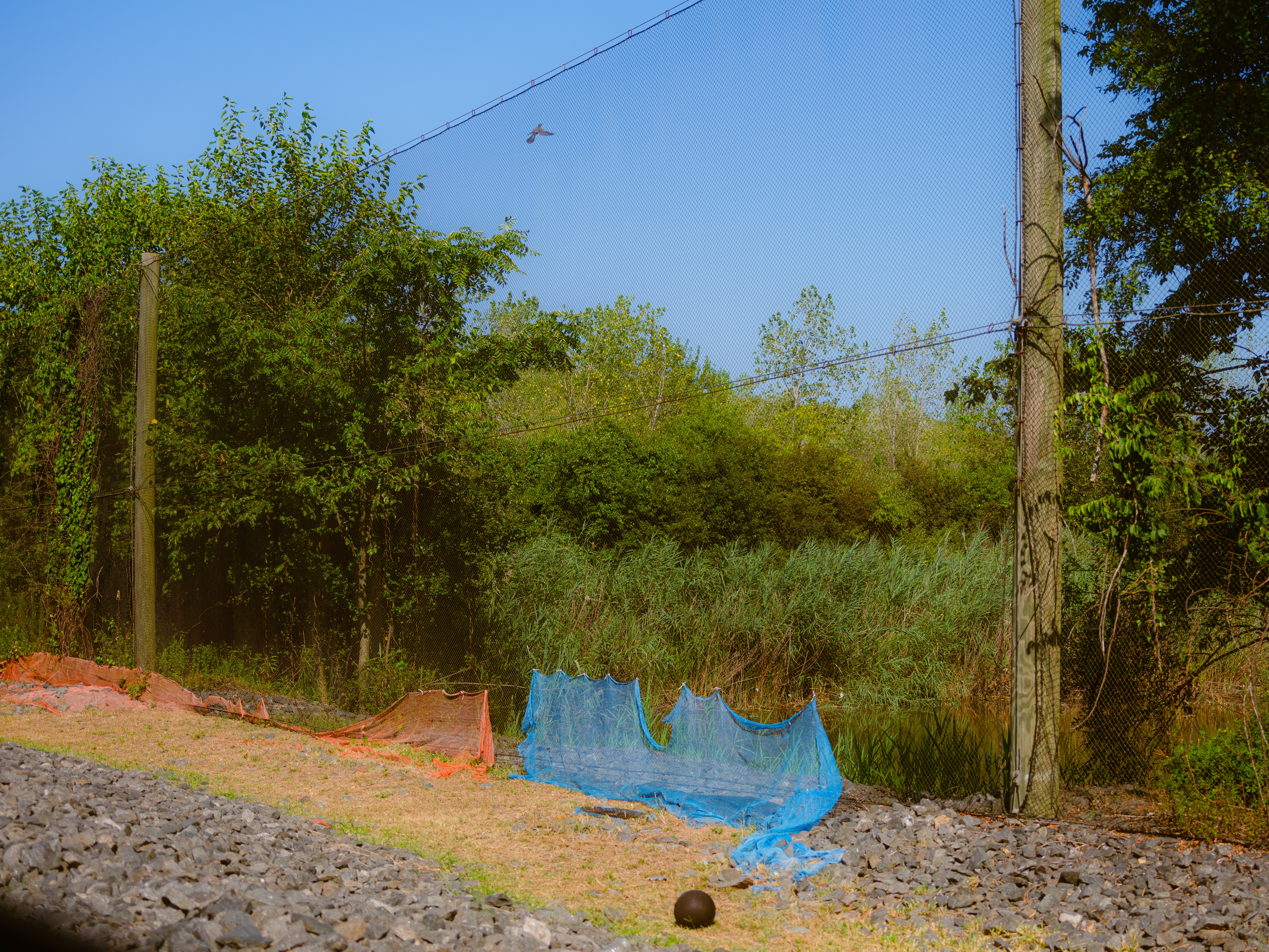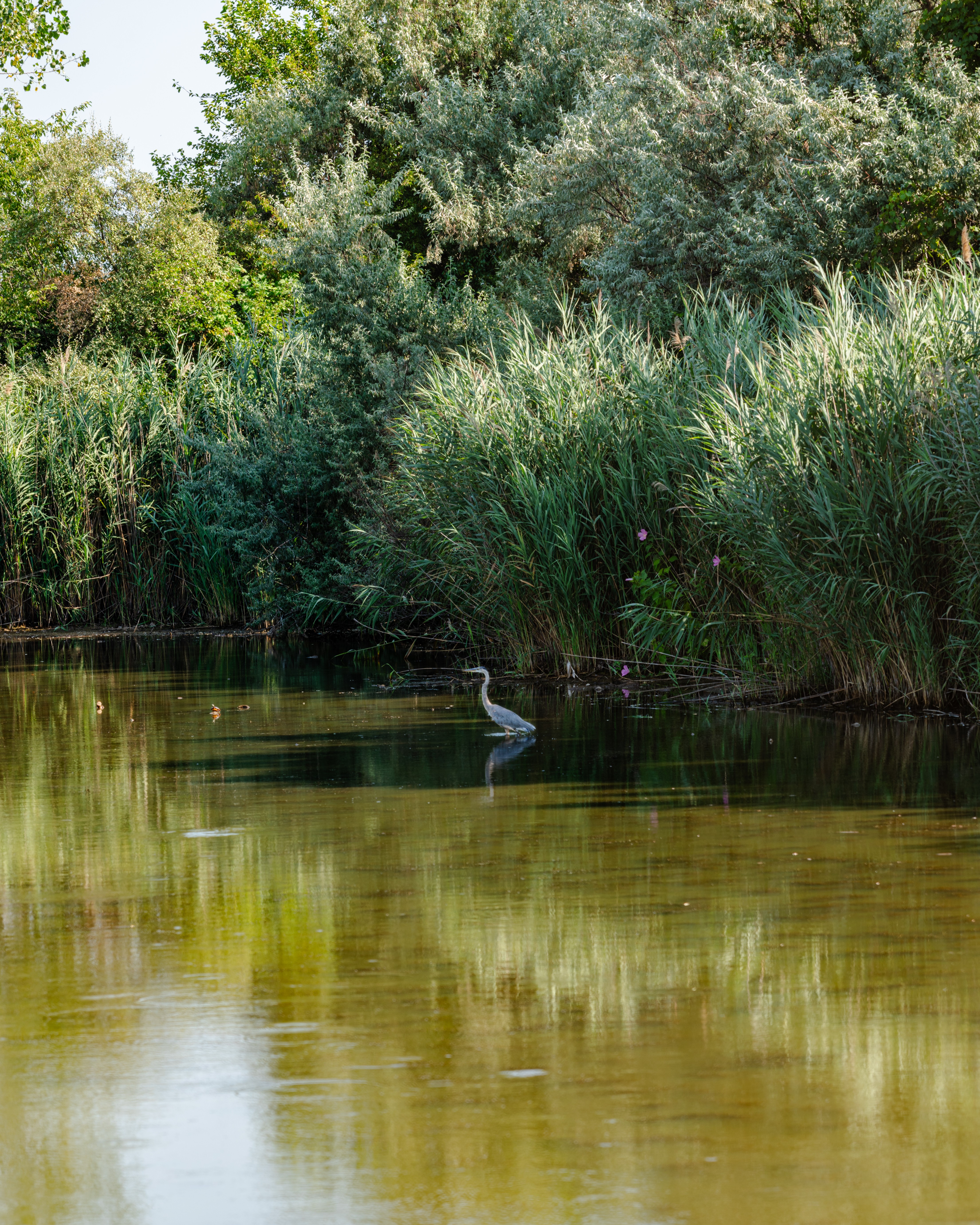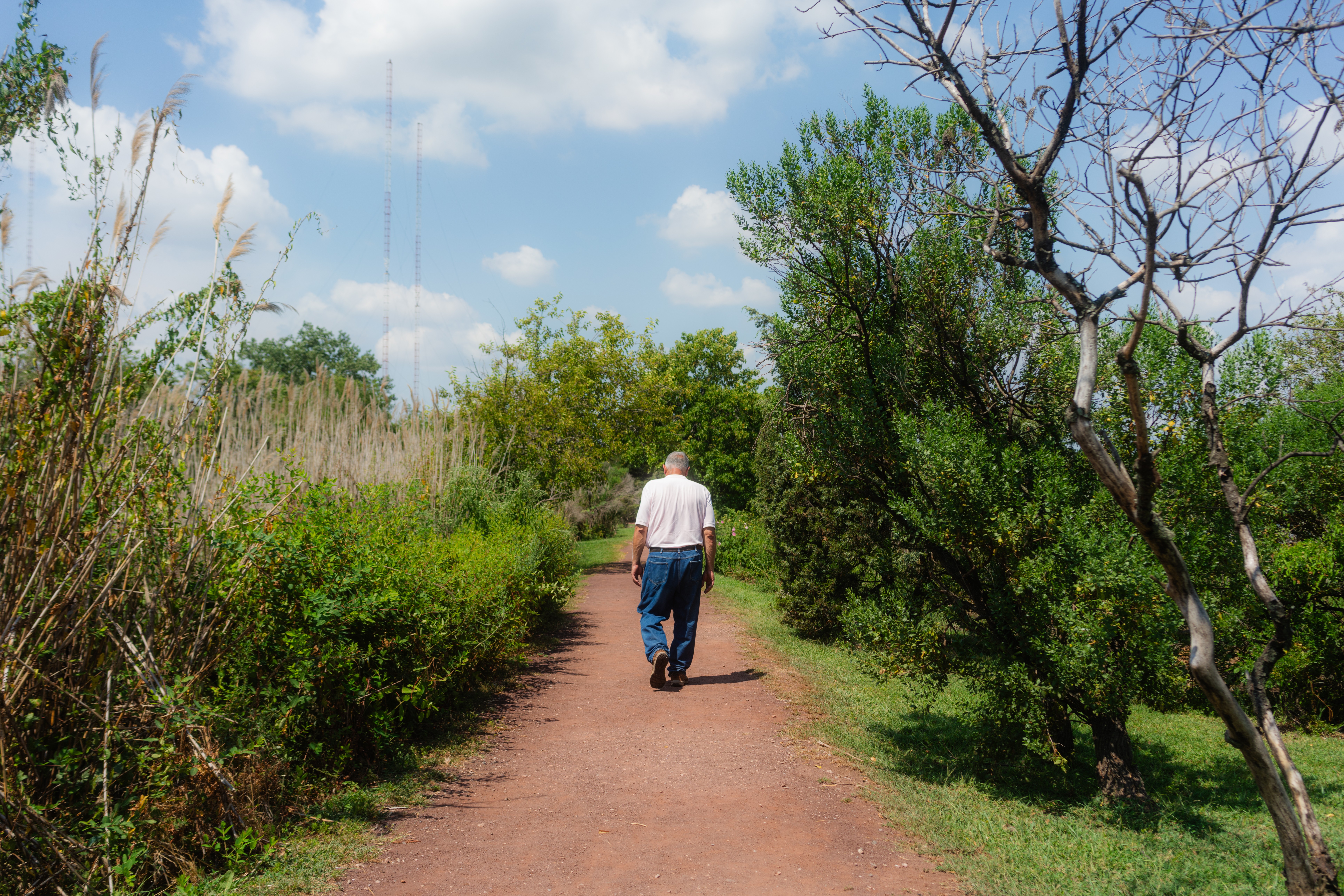Photographs and videos by Sydney Krantz
At night, the New Jersey Meadowlands can look like the entrance to hell. Smoke from a nearby garbage incinerator rises in plumes. The monstrous steel frame of a 3.5-mile bridge looms over cars racing in and out of New York City. For decades, such images defined the Meadowlands. The region was notorious as the fabled burial site of the Teamsters leader Jimmy Hoffa and the confirmed site of decades-long dump fires. It is the final resting place for household garbage, rubble from the London Blitz, the Doric columns of New York’s old Penn Station, and toxic sludge from chemical manufacturing.
But the Meadowlands are also a salt marsh, currently home to more than 300 species of birds and 50 species of fish. If, instead of simply passing through by car or train, visitors were to take a walk on one of the district’s trails or kayak through its creeks, they could look out across marshes and mudflats at cormorants, egrets, and osprey—all against the backdrop of the New York City skyline.
The Meadowlands will never be an Eden. The 12 lanes of the New Jersey Turnpike that pass through the district aren’t going anywhere anytime soon, nor are the Superfund sites. But since the 1970s, a combination of state and federal policies has steered the Meadowlands toward an unusual balance of waste disposal, development, and environmental protection. The naturalist John Quinn—who grew up at the edge of the district and wrote an illustrated guide to its history and ecology—once called the area’s transformation a “Lazarus-like” resurrection.
Legal protections for such places, however, are now under threat. In 2023, the Supreme Court ruling in Sackett v. Environmental Protection Agency restricted the reach of the Clean Water Act, rolling back its protections for the Meadowlands and places like them. This year, the Trump administration’s implementation of that ruling has fueled further concern among scientists: The Natural Resources Defense Council warns that it could put “an area larger than Nevada”—71 million acres of wetlands, all told—at risk of destruction. If the Meadowlands represent an ideal of 21st-century conservation—one that weighs human interests with ecological ones—then the possibility they represent is fast slipping away.
Tom Marturano, the recently retired director of solid waste and natural resources for the district, spent his career working to create this version of the Meadowlands. When he took his job, in 1984, they were still the wasteland that Quinn called “environmental Armageddon.” Marturano’s epithet of choice is “the dumping ground for all of society’s ills.” He was hired to implement state environmental regulations mandating the cleanup of the Meadowlands’ dumps to the point that they could be closed, one by one. Before he closed the dumps, Marturano also managed what went in them. He was once asked to accept a dead whale; another time, an entire shipping container of rotten garlic.

Those same landfills, now capped, are home to red-tailed hawks, falcons, and coyotes. Still, the Meadowlands’ wildlife habitats are not wild in the traditional sense of being free from human activity: They include gas pipelines, highway overpasses, tide gates, planted marsh grasses, and man-made islands. This planting and sculpting of the marshes has been done to restore their health, but many of the efforts have been funded, paradoxically, by development—including by American Dream, the second-largest mall in America.
From a distance, American Dream looks like a spaceship that touched down next to the Hackensack River. The mall, which opened in 2019, covers some 3 million square feet and contains an indoor ski area. To build it, developers were required to fund the enhancement of 15.37 acres of wetland to compensate for those they had filled or otherwise affected. This mitigation was mandated by the Clean Water Act, which regulates filling and dumping in wetlands. The funds from the mall went toward improving the health of a nearby section of marsh, which, Marturano told me, was once “nothing but solid phragmites”—an invasive grass that tends to reduce habitat diversity. Now native Spartina grasses have returned, as have muskrats and threatened bird species. Thanks to the conservation restrictions that come with mitigation, yellow-crowned night herons and American kestrels can count on a habitat for years to come; this patch of marsh cannot be developed.
Mitigation is the deal that America has struck between its interest in human development and the preservation of its wetlands since the Clean Water Act passed, in 1972. Opinions differ, even among those who work in the Meadowlands, about how good a deal it has been. Marturano credits the mitigation system with what he calls the Meadowlands’ “balance” of development and environmental protection. “Nobody,” he told me, would “just wake up one morning and say, ‘Let me enhance some wetlands.’” It’s too expensive.

Bill Sheehan, the executive director of Hackensack Riverkeeper, is more skeptical. Sheehan, who wears a shark tooth around his neck and a drooping white mustache around his mouth, has been the Meadowlands’ chief environmental advocate for 30 years. When I asked him to describe the role of mitigation in the district, his immediate response was: “It’s a scam.” Especially in the late 1990s, he explained, mitigation was just “an excuse to destroy wetlands.” Although he’s willing to support mitigation projects that he sees as serving a public good, he rejects the principle that improving the health of one wetland can compensate for the loss of another—not only because mitigation can fail, instead producing a bare mudflat, but also because these man-made attempts at ecological restoration are poor substitutes for nature’s own repair work.
Terry Doss, who co-directs the Meadowlands Research and Restoration Institute—a state agency that monitors water quality, sea-level rise, and wildlife habitat in the district—is more measured in her assessment than both Marturano or Sheehan. “Here in the Meadowlands, we have urban infrastructure,” she told me, “and so we will always have impacts. Therefore, we have to have mitigation.”
Right now, state laws still guarantee compensatory mitigation in the Meadowlands and protect them from unrestricted development. But, in 2023, the Supreme Court ruled that the Clean Water Act applies only to wetlands with a “continuous surface connection” to a navigable body of water. This decision was widely condemned by environmental groups but welcomed by those who saw it as protecting individual property rights, especially the rights of farmers. For the Meadowlands and places like them, where infrastructure such as highways and tide gates might interrupt a “continuous surface connection,” the 2023 decision meant the unraveling of federal protections.
Still, when I asked Doss what she sees as the single greatest threat to the Meadowlands today, she spoke immediately of people’s perceptions of the region. “People tend to say, ‘Oh, it’s just phragmites; it’s just a ditch,’” she replied. “‘It’s polluted, you know. Move on.’”

For most of the Meadowlands’ history, this is how people saw them. The region’s shifting, mosquito-ridden ground was considered worthless land that needed to be “reclaimed”—drained or filled so that it could be used for agriculture (in the 19th century), for infrastructure and solid waste (in the 20th century), or for housing and warehousing (in the 21st). But over the past 50 years, ecologists have come to value wetlands not only as wildlife habitats but also as carbon sinks, defenses against rising seas, and filters for harmful pollutants. Preserving wetlands in concert with human infrastructure—as part of, rather than apart from, where people live—makes those places more aesthetically appealing, ecologically robust, and economically resilient.
Enhancing a marsh requires its own kind of balance: Reestablishing Spartina grasses, Marturano told me, can mean using bulldozers outfitted with snowshoe-like tracks to bring the marsh down to a particular elevation. If the marsh is brought too low, nothing will grow, and it will become a mudflat. If the marsh isn’t cut low enough, the phragmites will remain and crowd out the Spartina grasses. Marturano took me through these stages as we walked across a former mitigation site. He stopped to point out a muskrat hut, a pair of hawks, a groundhog hole, and a group of cormorants. He may be an engineer by training, but the Meadowlands have given him a naturalist’s eye for the habits of nonhuman creatures.

Some 3,500 acres of the Meadowlands, a patchwork of conservation areas and mitigation sites, are now protected from further human development. Many of the region’s human structures—highways, rail lines—are protected, at least for the foreseeable future, by their use to millions of people. The question is not, then, whether the marsh or the human infrastructure will disappear completely, but how the balance between the two will—or won’t—be maintained.
The post New Jersey’s Most Notorious Dump Is a Model of Conservation appeared first on The Atlantic.




